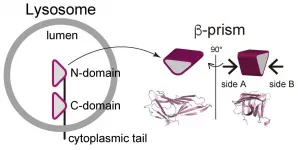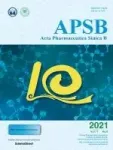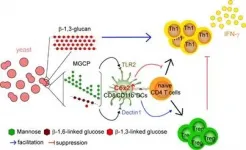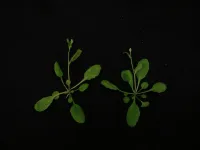A direct look at OLED films leads to some pretty exciton findings
Researchers from the University of Tsukuba use time-resolved photoemission electron microscopy to probe the electron dynamics of solid-state film OLEDs
2021-06-25
(Press-News.org) Tsukuba, Japan - Organic light-emitting diodes (OLEDs) are widely used in display technology and are also being investigated for lighting applications. A comprehensive understanding of these devices is therefore important if their properties are to be harnessed to their full potential. Researchers from the University of Tsukuba have directly observed the photoexcited electron dynamics in an organic film using time-resolved photoelectron emission microscopy. Their findings are published in Advanced Optical Materials .
OLED displays are popular because they are bright, lightweight, and do not consume a lot of power. Their output is generated when an exciton--a combination of an electron and an electron hole--releases its energy. However, this release is not possible for all OLED excitons, which makes their overall efficiency low.
To address this limitation, researchers are focusing on OLEDs that exhibit thermally activated delayed fluorescence (TADF-OLEDs), which show efficiencies of up to 100%.
However, details of the electron dynamics that affect their performance are not fully understood. Attempts to learn more have used poorly defined models, meaning the findings have been difficult to interpret and apply to other systems.
The researchers focused on a single-component, solid-state film of a material known as 4CzIPN and investigated it using time-resolved photoemission electron microscopy (TR-PEEM). They compared their findings with observations made using the more commonly used time-resolved photoluminescence (TR-PL) method to try to establish details of the decay process that were previously unknown.
"Solid-state films are excellent materials for OLEDs because they make the device fabrication process simpler, reduce the degradation that is often seen, and exhibit excellent quantum efficiencies," explains study corresponding author Professor Yoichi Yamada. "The trouble is that we still don't fully understand what is happening to the excitons, so there's the possibility that we could be making them even better."
The researchers successfully detected the photoexcited electron dynamics of the TADF solid-state film using TR-PEEM. And by comparing with TR-PL results they identified long-lived electrons that they believe were formed by the dissociation of excitons.
They found that up to 4% of the excitons formed may dissociate and become trapped in the film. Very little evidence for this has been noted using other techniques.
"In addition to detecting a feature of exciton decay in TADF-OLEDs that has not been directly observed to date; we also demonstrated the potential of the TR-PEEM method," Professor Yamada explains. "We believe our findings will make a significant contribution to the development of efficient OLED-based products."
INFORMATION:
The article, "Direct Observation of Photoexcited Electron Dynamics in Organic Solids Exhibiting Thermally Activated Delayed Fluorescence via Time-resolved Photoelectron Emission Microscopy", was published in Advanced Optical Materials at DOI: 10.1002/adom.202100619.
[Attachments] See images for this press release:
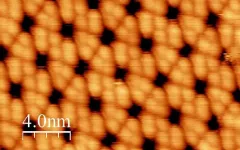
ELSE PRESS RELEASES FROM THIS DATE:
2021-06-25
Tokyo, Japan - A cell is composed of numerous organelles, each with a unique role that helps contribute to its overall functionality. The lysosome is an organelle that contains digestive enzymes and functions as a molecular garbage disposal and recycling center. Since the role of lysosome is crucial to maintain the cellular homeostasis, the lysosomal dysfunction causes neurodegenerative and metabolic diseases, cancer, as well as lysosomal storage disorders.
In a new article published in Autophagy, researchers at Tokyo Medical and Dental University (TMDU) performed a novel type of structural analysis to demonstrate how a certain molecular interaction is crucial for one lysosomal membrane protein to perform effectively.
LAMP1 (lysosomal-associated ...
2021-06-25
LA JOLLA, CA--Chemists at Scripps Research have solved a long-standing problem in their field by developing a method for making a highly useful and previously very challenging type of modification to organic molecules. The breakthrough eases the process of modifying a variety of existing molecules for valuable applications such as improving the potency and duration of drugs.
The flexible new method, for "directed C--H hydroxylation with molecular oxygen," does what only natural enzymes have been able to do until now. It's described in a paper this week in Science.
"We ...
2021-06-25
James Cook University scientists in Australia believe they have made a breakthrough in the science of keeping premature babies alive.
As part of her PhD work, JCU engineering lecturer Stephanie Baker led a pilot study that used a hybrid neural network to accurately predict how much risk individual premature babies face.
She said complications resulting from premature birth are the leading cause of death in children under five and over 50 per cent of neonatal deaths occur in preterm infants.
"Preterm birth rates are increasing almost everywhere. In neonatal intensive care units, assessment of mortality risk assists in making difficult decisions regarding which treatments should be used and if and when treatments are working effectively," said Ms Baker. ...
2021-06-25
RICHLAND, Wash.--Earth bears many signs of human influence, from warming that exceeds pre-industrial temperatures to a rising sea. Add to that list, now, the human influence on the timing of Earth's water cycle, revealed by a new study led by researchers at the U.S. Department of Energy's Pacific Northwest National Laboratory.
The research, published this week in the journal Nature Climate Change, peels back layers of climatological noise to uncover a clear signal: from 1979 to 2019, increases in greenhouse gases and reductions in human-generated aerosols triggered an approximate four-day delay in seasonal rainfall over tropical land and the Sahel. The lag could mean delayed crop production, ...
2021-06-25
We can generally recognize an object, even if it is presented for a very brief time. However, if another object appears immediately following the first object, the perception on the first object is impaired such that we do not notice its existence. This perceptual phenomenon, called "visual backward masking," is used in vision science to study how visual perception is processed in the brain. Interestingly, this phenomenon occurs even if the second object does not spatially overlap the first object, such as a contour or four dots surrounding the object.
The occurrence of this phenomenon is assumed to be due to a disruption of "feedback processing." When we see something, visual ...
2021-06-25
In 2021 Acta Pharmaceutica Sinica B (APSB) is celebrating its 10th anniversary. The journal was founded with the goal of creating a global high-level forum centred around drug discovery and pharmaceutical research/application. APSB was included by Chemical Abstracts in 2011, accepted by PubMed Central in 2015, indexed by Science Citation Index in 2017 and has evolved to become one of the most important international journals in the field of pharmaceutical sciences.
Volume 11, issue 6 is a special issue marking the beginning of a series of celebratory events ...
2021-06-25
The development of therapeutic drugs for inflammatory bowel disease, an intractable immune disease, and multiple sclerosis - an autoimmune disorder - is gaining traction. A research team from the Department of Life Sciences at POSTECH and a joint research team at ImmunoBiome Inc. have uncovered that a yeast-derived polysaccharide mixture inhibits the onset and progression of immune disorders.
The number of cases of Crohn's disease and ulcerative colitis - both inflammatory bowel diseases - in Korea was about 18,000 and 37,000 respectively as of 2019, increasing about 2.3 times ...
2021-06-25
With a goal of breeding resilient crops that are better able to withstand drought and disease, University of California San Diego scientists have developed the first CRISPR-Cas9-based gene drive in plants.
While gene drive technology has been developed in insects to help stop the spread of vector-borne diseases such as malaria, researchers in Professor Yunde Zhao's lab, along with colleagues at the Salk Institute for Biological Studies, demonstrated the successful design of a CRISPR-Cas9-based gene drive that cuts and copies genetic elements in Arabidopsis plants.
Breaking ...
2021-06-25
Tsukuba, Japan - The COVID-19 pandemic has changed the way people eat, work, shop and go to school. Now, researchers from Japan have found surprising differences in the way people use healthcare services--including house calls from doctors.
In a study published this month in BMC Emergency Medicine, researchers from the University of Tsukuba have revealed that patterns in illness type and severity did change during the pandemic--with unexpected trends that may tell us about how people use health care services when personal contact carries inherent risk.
In Tokyo, private after-hours house call services (AHHC) provide in-home medical service outside of regular ...
2021-06-25
Quantum dots (QDs) are semiconductor particles only a few nanometers across that, thanks to their small size, exhibit peculiar optical and electronic properties due to quantum mechanics. With existing and foreseen applications in screens, lighting, lasers, and energy harvesting, research in quantum dots has been steadily progressing. In particular, colloidal QDs (CQDs) have been in the nanotechnology spotlight for over a decade.
CQDs are semiconductor nanocrystals that can be produced easily from solution-based processes, which make them suitable for mass production. However, for CQD-based devices to operate at their best, the quantum dots should be monodisperse--that is, ...
LAST 30 PRESS RELEASES:
[Press-News.org] A direct look at OLED films leads to some pretty exciton findings
Researchers from the University of Tsukuba use time-resolved photoemission electron microscopy to probe the electron dynamics of solid-state film OLEDs

